The human body often reacts sharply to overwork and stress, especially after 30 years. A feeling of heaviness, acute back pain in the lumbar region are all symptoms of stress or signs of the onset of serious illness, so you should not just ignore them. Why does the back hurt and how to treat it?
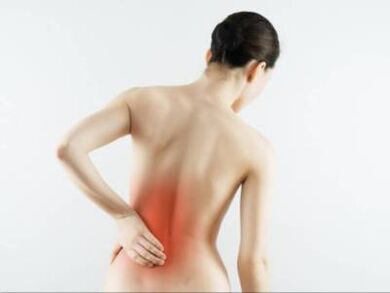
symptoms
The difficulty of the correct diagnosis lies in the fact that many diseases can manifest themselves in this way, and it can also be a reaction of the body to various external and internal stimuli.
Finding out why the back hurts and making the correct diagnosis will help to correctly analyze the very different symptoms.
Where is the waist? This is an area of the back, covering the territory from the coccyx to the ribs, that contains many nerve endings and is divided in half by the spine.
In order to make a correct diagnosis, it is necessary to assess the location of unpleasant sensations:
- Above the waist, right or left - such a symptom can be an indicator of inflammation of the internal organs: liver (right) and kidneys (right or left just above the waist). They can also be caused by hepatitis, liver failure, polycystic diseases, cancer, pyelonephritis. In the case of kidney inflammation, symptoms can radiate into the abdomen and hypochondrium.
- Below the waist - such symptoms characterize problems with the spine (lumbago, hernia, curvature), menstrual cramps and diseases of the genital organs in women, intestines, inflammation of the appendix and genitourinary system in men.
Important! Unpleasant sensations in the back can appear as a result of inflammation in the body and serious problems.
It is also important to assess the nature of the painful sensations:
- Shooting is a symptom of a pinched sciatic nerve. When this nerve process in the back becomes inflamed, there is a burning, shooting or tingling sensation, the duration and intensity of which can vary. They are especially aggravated by a change in body position, so most of the time a person can only stay in one position.
- Sharp pains in the lower back, mostly shooting. In addition, a person experiences a pull in the back and cannot move normally, choosing a comfortable position. Such sensations can be symptoms of: diseases of the lungs and genitourinary system, displacement of the intervertebral discs, renal colic, muscle tension.
- Chronic - constant discomfort in the back area, which disappears for a short time after taking painkillers, but then returns. They indicate spondylosis, osteomyelitis, tumors and metabolic disorders.
- Lower back pain - occurs suddenly, but lasts for a long time. Weak painful sensations are symptoms of myositis, overstrain or hypothermia of the muscles;
- Displaced - occur in diseases of the colon, pelvic organs, pancreas or tumors.
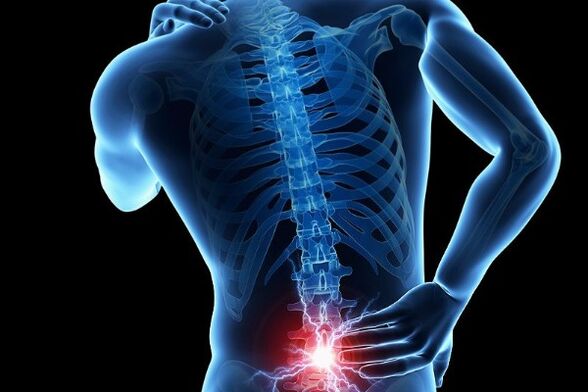
Important! Heaviness in the lower back is also a symptom of the inflammatory process of the internal organs or muscles.
It is urgent to consult a doctor if the back pain is localized, chronic, and at the same time there is numbness and weakness in the limbs.
The reasons
There are several groups of different causes that can cause back pain. They are divided into natural and pathological or acquired.
The natural ones include:
- heavy physical exertion - due to the accumulation of lactic acid, muscle tissue loses elasticity and begins to swell;
- sedentary work - due to lack of exercise and, as a result, impaired blood circulation, heaviness appears in the lower back;
- Disorders in the digestive system that can radiate to the back;
- a long stay in the cold - low temperatures shrink the vessels and slow blood flow, which causes discomfort;
- Stress - with this phenomenon, there are spasms of the muscles of the spine, which causes a feeling of squeezing and discomfort.
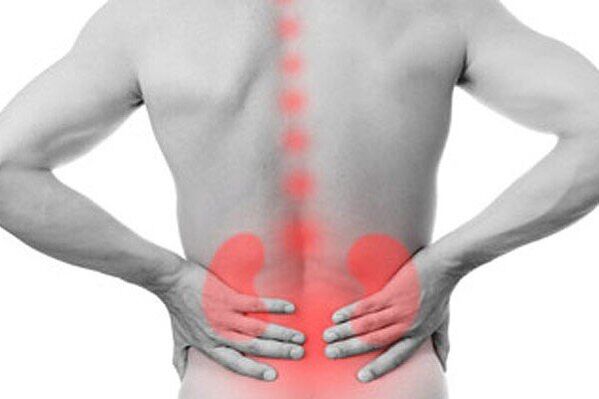
Pathological causes are:
- Diseases of the spine - negative processes in it lead to serious diseases, which are accompanied by constant discomfort;
- Vascular diseases and heart diseases - if the spasms are concentrated in the area of \u200b\u200bthe shoulder blades and below, and are also accompanied by a feeling of squeezing, a drop in pressure and shortness of breath, then these are symptoms of atherosclerosis and ischemia;
- Inflammation of the sciatic nerve - if there is a sharp pain in the lower back and a person can only be in one position, then most likely this nerve has a cold;
- Inflammation of the genitourinary system - nephritis, colpitis, endometritis and other diseases lead to swelling of the organs and their tissues in the waist area;
- muscle inflammation;
- Trauma;
- Diseases of the bronchopulmonary system.
Important! Due to the different structure and properties of the body in women and men, back pain can be a symptom of completely different processes in them.
Lower back pain in men can be related to:
- pathologies in the kidneys;
- reproductive system problems;
- consequences of trauma.
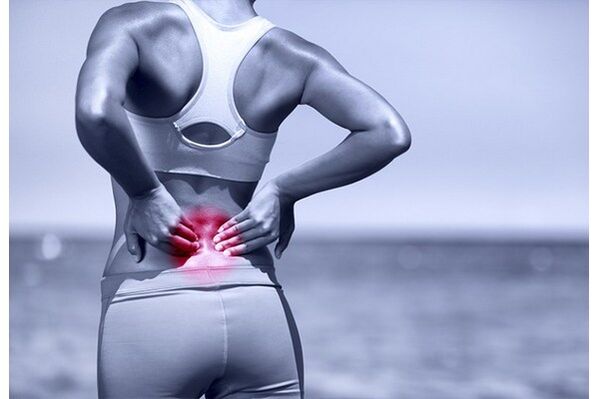
Lower back pain in men over the age of 35 is very common because it is at risk at this age. Therefore, at the slightest symptoms, you should contact the clinic. The risk group also includes men who:
- work physically;
- lead a sedentary lifestyle;
- are overweight and have bad habits;
- have weak immunity.
Which doctor do you contact if you have problems? First, to the therapist, who, after receiving the first data and analyzes, sends the patient to an infectious disease specialist, gastroenterologist, cardiologist, urologist, nephrologist, neuropathologist or proctologist.
Women also often have lower back pain, but the reasons for this can be very different from those of men.
There is no single answer, it could be:
- Premenstrual syndrome or cramps during menstruation - due to delays, hormonal imbalances, uterine contractions, tension and swelling of the tissues of the genitourinary system, there is tension in the pelvis and back pain in the lumbar region.
- Pregnancy - The increase in body weight creates increased pressure on a woman's spine, leading to lower back tension in women. It should be noted that in the early stages, heaviness and pain in the lower back can be a signal of the threat of miscarriage. Therefore, consult a doctor immediately if this occurs.
- After childbirth - if the girl had problems with the spine before childbirth, then after childbirth they do not go away, but, on the contrary, have the peculiarity of intensifying due to the possible displacement of the intervertebral discs or their pinching.
- Gynecological diseases - lower back pain in women, which accompanies all inflammatory processes in the organs of the genitourinary system, occurs regardless of the load. Because of them, there is heaviness and aching pain in the lower back. If acute pain occurs in the lower back, this is a symptom of an ovarian rupture or an ectopic pregnancy.
- Problems with the internal organs and spine.
The female risk group includes women who:
- have infections of the genitourinary system;
- the intestine is unstable;
- there are tumor diseases;
- sedentary work;
- complications after colds;
- physiological changes;
- excessive physical activity;
- increased body weight;
- Past experience with epidural anesthesia.
In addition to diseases and inflammatory processes in the body, there are a number of provoking factors that cause pain in the lower back:
- hypothermia;
- sedentary lifestyle and infrequent physical activity;
- excessive physical activity;
- Professional athletes, bodybuilders, bodybuilders, weightlifters should be especially careful.
If you belong to one of the risk groups, you should exercise regularly under the supervision of a qualified trainer and be observed by a doctor to take preventive measures to prevent the occurrence of back problems.
treatment
If back problems have already occurred, preventive measures will not help. You should consult a doctor, find out the exact cause and start treatment. You can use the methods of traditional medicine or turn to traditional ones, but all actions should be agreed with your doctor. Which doctor should I contact? First of all, to the therapist, and after finding out the reasons - to a narrow specialist.
home remedies
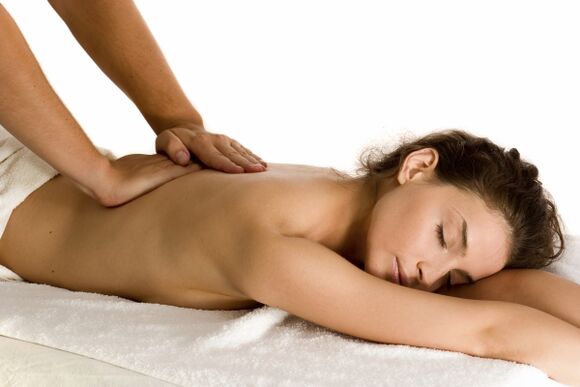
Traditional medicine involves the use of various methods of struggle:
- Massage – massaging a stiff back helps relieve tension and swelling. You can do a massage yourself or turn to a specialist, but only a proven one, so that he does not aggravate the problems that have already arisen.
- Physical Exercises - Regular exercise and warm-up exercises throughout the day are done to relax muscles and release tension in muscles.
- Compresses - to relieve tissue swelling, compresses should be made from cabbage, burdock leaves and plantains. After dressing and wrapping your back with a warm scarf, you should lie down quietly for half an hour.
Traditional medicine can also be used as a prophylactic to prevent serious problems. But if back pain in the lumbar region increases and massage, compresses and exercises do not bring relief, you should immediately consult a therapist.
Contacting a doctor
If discomfort and aching pain in the lower back do not go away, and traditional medicine and massage do not help, how to treat? First of all, you should consult a therapist and find out their cause. For diagnosis, the back is examined in several ways:
- X-rays are taken to look for injuries.
- Ultrasound examinations are carried out to rule out diseases and inflammation of the internal organs. An MRI with CT can also be performed for this purpose.
- General and biochemical analyses.
- ECG and gastroscopy are performed to exclude heart disease and diseases of the gastrointestinal tract.
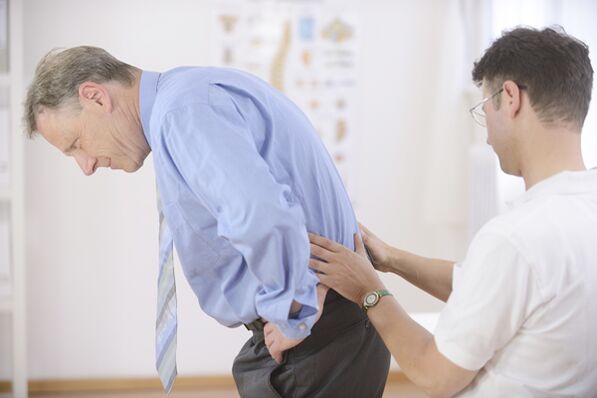
After an accurate diagnosis is made, the patient is prescribed appropriate treatment measures:
- Problems with the spine, joints and muscles are treated with non-steroidal drugs, courses of therapeutic exercises and massage;
- Cardiovascular disease is treated by limiting physical activity and prescribing appropriate medication;
- Diseases of the digestive tract imply compliance with a strict diet and drugs that envelop the intestines;
- bronchopulmonary pathologies are treated with antibacterial and antiviral drugs;
- Problems of the pelvic organs - antimicrobial agents and physiotherapy.
In addition, you should also deal with prevention:
- bear no weight;
- always keep your back straight;
- sleeping on a hard mattress;
- avoid hypothermia, stress and overeating;
- treat acute illnesses in a timely manner.
Back pain is easy to prevent with timely prevention: A healthy lifestyle, regular moderate exercise - all this helps to prevent back problems and alleviate existing ones.




















